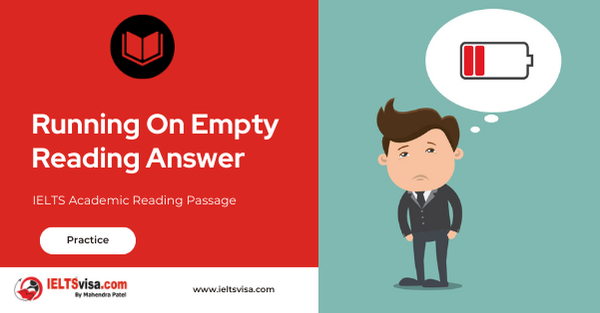Running On Empty Reading Answer
IELTS Academic Reading Passage
A revolutionary new theory in sports physiology.
A
For almost a century, scientists have presumed, not unreasonably, that fatigue – or exhaustion in athletes originates in the muscles. Precise explanations have varied but all have been based on the ‘limitations theory’. In other words, muscles tire because they hit a physical limit: they either run out of fuel or oxygen or they drown in toxic by-products.
B
In the past few years, however, Timothy Noakes and Alan St Clair Gibson from the University of Cape Town, South Africa, have examined this standard theory. The deeper they dig, the more convinced they have become that physical fatigue simply isn’t the same as a car running out of petrol. Fatigue, they argue, is caused not by distress signals springing from overtaxed muscles, but is an emotional response which begins in the brain. The essence of their new theory is that the brain, using a mix of physiological, subconscious and conscious cues, paces the muscles to keep them well back from the brink of exhaustion. When the brain decides its time to quit, it creates the distressing sensations we interpret as unbearable muscle fatigue. This ‘central governor* theory remains controversial, but it does explain many puzzling aspects of athletic performance.
C
A recent discovery that Noakes calls the ‘lactic acid paradox’ made him start researching this area seriously. Lactic acid is a by-product of exercise, and its accumulation is often cited as a cause of fatigue. But when research subjects exercise in conditions simulating high altitude, they become fatigued even though lactic acid levels remain low. Nor has the oxygen content of their blood fallen too low for them to keep going. Obviously, Noakes deduced, something else was making them tire before they hit either of these physiological limits.
D
Probing further, Noakes conducted an experiment with seven cyclists who had sensors taped to their legs to measure the nerve impulses travelling through their muscles. It has long been known that during exercise, the body never uses 100% of the available muscle fibres in a single contraction. The amount used varies, but in endurance tasks such as this cycling test the body calls on about 30%.
E
Noakes reasoned that if the limitations theory was correct and fatigue was due to muscle fibres hitting some limit, the number of fibres used for each pedal stroke should increase as the fibres tired and the cyclist’s body attempted to compensate by recruiting an ever-larger proportion of the total. But his team found exactly the opposite. As fatigue set in, the electrical activity in the cyclists’ legs declined – even during sprinting, when they were striving to cycle as fast as they could.
F
To Noakes, this was strong evidence that the old theory was wrong. ‘The cyclists may have felt completely exhausted,’ he says, ‘but their bodies actually had considerable reserves that they could theoretically tap by using a greater proportion of the resting fibres.’ This, he believes, is proof that the brain is regulating the pace of the workout to hold the cyclists well back from the point of catastrophic exhaustion.
G
More evidence comes from the fact that fatigued muscles don’t actually run out of anything critical. Levels of glycogen, which is the muscles’ primary fuel, and ATP. the chemical they use for temporary energy storage, decline with exercise but never bottom out. Even at the end of a marathon, ATP levels are 80-90% of the resting norm, and glycogen levels never get to zero.
H
Further support for the central regulator comes from the fact that top athletes usually manage to go their fastest at the end of a race, even though, theoretically, that’s when their muscles should be closest to exhaustion. But Noakes believes the end spurt makes no sense if fatigue is caused by muscles poisoning themselves with lactic acid as this would cause racers to slow down rather than enable them to sprint for the finish line. In the new theory, the explanation is obvious. Knowing the end is near, the brain slightly relaxes its vigil, allowing the athlete to tap some of the body’s carefully hoarded reserves.
I
But the central governor theory does not mean that what’s happening in the muscles is irrelevant. The governor constantly monitors physiological signals from the muscles, along with other information, to set the level of fatigue. A large number of signals are probably involved but, unlike the limitations theory, the central governor theory suggests that these physiological factors are not the direct determinants of fatigue, but simply information to take into account.
J
Conscious factors can also intervene. Noakes believes that the central regulator evaluates the planned workout, and sets a pacing strategy accordingly. Experienced runners know that if they set out on a 10-kilometre run. the first kilometre feels easier than the first kilometre of a 5-kilometre run, even though there should be no difference. That, Noakes says, is because the central governor knows you have farther to go in the longer run and has programmed itself to dole out fatigue symptoms accordingly.
K
St Clair Gibson believes there is a good reason why our bodies arc designed to keep something back. That way, there’s always something left in the tank for an emergency. In ancient times, and still today, life would be too dangerous if our bodies allowed us to become so tired that we couldn’t move quickly when faced with an unexpected need.
Questions 1-6
Reading Passage 3 has eleven paragraphs A-K.
Choose the correct heading for Paragraphs A-F from the list of headings below. Write the correct number (i-viii) in boxes 1-6 on your answer sheet.
List of headings
i.Avoiding tiredness in athletes
ii. Puzzling evidence raises a question
iii.Traditional explanations
iv. Interpreting the findings
V. Developing muscle fibres
vi.A new hypothesis
vii.Description of a new test
viii. Surprising results in an endurance test
Example:
1. Paragraph A
2. Paragraph B
3. Paragraph C
4. Paragraph D
5. Paragraph E
6. Paragraph F
Questions 7-13
Classify the following ideas as relating to
A the Limitations Theory
B the Central Governor Theory
C both the Limitations Theory and the Central Governor Theory
Write the correct letter A, B or C in boxes 7-13 on your answer sheet.
NB: You may use any letter more than once.
7.Lactic acid is produced in muscles during exercise.
8.Athletes can keep going until they use up all their available resources.
9.Mental processes control the symptoms of tiredness.
10. The physiological signals from an athlete’s muscles are linked to fatigue.
11. The brain plans and regulates muscle performance in advance of a run.
12. Athletes’ performance during a race may be affected by lactic acid build up.
13. Humans are genetically programmed to keep some energy reserves.

Solutions For:- Running On Empty Reading Answer
|
1. iii |
8. A |
|
2. vi |
9. B |
|
3. ii |
10. C |
|
4. vii |
11. B |
|
5. viii |
12. A |
|
6. iv |
13. B |
|
7. C |
Review and Practice
- Regularly practice with IELTS reading samples and time yourself to get used to the pressure of the exam.
- Review your mistakes to understand where you went wrong and how to avoid similar errors in the future.
Our Books
Master IELTS Speaking Part 1
IELTS Writing Task 1 Book
IELTS Writing Task 2 Book
Running On Empty Reading Answer Explanation
Comin Soon
Practice IELTS Other Modules
IELTS Listening
The IELTS Listening test assesses how well you can understand spoken English in various contexts. It lasts about 30 minutes and is divided into four sections with a total of 40 questions. The listening tasks become increasingly difficult as the test progresses.
IELTS Academic Reading
The IELTS Academic Reading section assesses your ability to understand and interpret a variety of texts in academic settings. It is designed to evaluate a range of reading skills, including skimming for gist, reading for main ideas, reading for detail, understanding inferences, and recognizing a writer's opinions and arguments.
IELTS Speaking
The IELTS Speaking test assesses your ability to communicate in English on everyday topics. It lasts 11-14 minutes and consists of three parts: introduction, cue card, and a discussion based on the cue card topic.
IELTS General Reading
IELTS General Reading tests your ability to understand and interpret various types of texts. Here are some key areas and types of content you can expect to encounter in the reading section, along with tips for effective preparation.
IELTS Academic Writing Task 1
In IELTS Academic Writing Task 1, you are presented with a visual representation of information, such as graphs, charts, tables, or diagrams, and you are required to summarize, compare, or explain the data in your own words.
IELTS General Writing Task 1
In IELTS General Writing Task 1, you are required to write a letter based on a given situation. The letter can be formal, semi-formal, or informal, depending on the prompt. Here’s a breakdown of the key components to include in your letter
IELTS Academic Writing Task 2
In IELTS Academic Writing Task 2, you are required to write an essay in response to a question or topic. Here’s a guide to help you understand the essential elements of this task
IELTS Exam Tips
To succeed in the IELTS exam, practice regularly, familiarize yourself with the test format, improve your vocabulary, develop time management skills, and take mock tests to build confidence.
Grammer for IELTS
Grammar is the foundation of effective communication in English. Understanding tense usage, subject-verb agreement, and sentence structure enhances clarity and coherence in writing and speaking.
Vocabulary for IELTS
Vocabulary plays a crucial role in the IELTS (International English Language Testing System) exam, especially in the Speaking and Writing sections. Here’s an overview of why vocabulary is important and how it impacts your performance
RECENT IELTS SAMPLES QUESTIONS AND ANSWERS
Back to the Future Skyscraper Design
A. “The Recovery of Natural Environments in Architecture” by Professor Alan Short represents...
UNMASKING SKIN
AIf you took off your skin and laid it flat, it would cover an area of about twenty-one square...
The World is Our Oyster Reading Answer
A. Independent travel is on the increase and while package holidays which offer an all...
Investigating Children’s Language
A For over 200 years, there has been an interest in the way children learn to speak and...
Why companies should welcome disorder
A Organisation is big business. Whether it is of our lives – all those inboxes and calendars –...
Saving bugs to find new drugs
A More drugs than you might think are derived from, or inspired by, compounds found in living...













